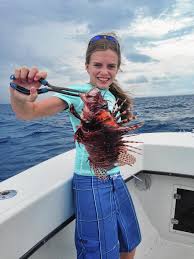When 12-year-old Lauren Arrington of Jupiter, Fla., designed a project for her school’s science fair, little did she know she would make a breakthrough that would radically change the way scientists think about the venomous, highly invasive lionfish, or that it would get her cited in a published, peer-reviewed study on the subject.

The lionfish, a native of Indo-Pacific waters, has invaded the reefs of the Southeast U.S. and Caribbean. The venomous, ravenous and highly prolific fish have no natural predators and are displacing native and economically important species such as grouper and snapper. Recent estimates of lionfish densities indicate that they have surpassed some native species, with the highest estimates reporting over 1,000 lionfish per acre in some locations, according to the National Centers for Coastal Ocean Science.
Challenged to come up with a project for her sixth-grade science fair, the daughter of two scientists and an avid water enthusiast concerned about the devastation the lionfish are causing on the reefs, Lauren decided to focus on the invaders. After passing on the idea of seeing how the fish’s venom affects humans (too hard to find volunteers to be spined), she devised a test to determine what levels of salinity the fish could survive.
Starting with test and control aquariums filled with normal ocean water, over two weeks Lauren slowly diluted the water in the test aquarium from the salinity of normal sea water (35 parts per 1,000). She and her father, who has a doctorate in fish ecology, thought the lionfish would withstand a salinity of 13 and no less. She eventually took it down to six parts per 1,000 with no ill effects to the lionfish.
“We were completely dumbfounded,” her father told the Palm Beach County Sun Sentinel. “We did not expect that at all.”
Because the science fair guidelines specified that no animals could be harmed during the experiments, Lauren stopped there. But the implications of her work didn’t.
Craig Layman, an ecology professor at North Carolina State University, noted that her finding was something scientists should have investigated years ago, and called her work “one of the most influential sixth-grade science projects ever conducted.” That’s because it revealed that the lionfish could live – and breed in – estuaries, something never previously contemplated.

Her project inspired further research by Layman who said Lauren’s project was the impetus for his team to follow up and do a more in-depth study. “We were the first paper that published the salinity of the lionfish, and it was all because of what she had done with her science project,” he said. The expanded study showed that lionfish can survive salinity as low as five parts per 1,000, and even pulses of totally fresh water, meaning that lionfish could move into estuaries which often serve as fish nurseries.
The study, “Broad salinity tolerance in the invasive lionfish Pterois spp. may facilitate estuarine colonization,” conducted by Layman and his students, was published this year in the Environmental Biology of Fishes. Lauren’s name is mentioned in the acknowledgments section of the research paper.
“Sometimes it takes someone outside of science – or a student – to look at something in a different way,” Layman said.
Lauren’s thoughts? “It was pretty cool,” she told the Sun Sentinel.
Recommended:
Discovery Channel Daily Planet Lionfish Episode Part 1 Invasion Basics and Field Work
Discovery Channel Daily Planet Lionfish Episode Part 2 Lionfish Reproduction

Yay for science!